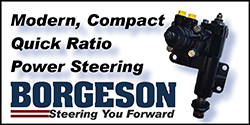But You really ought to be using the bore they were designed for, 3.91", a .030" over 340 bore isn't OE representative......to be accurate..It is a borrowed head from a 318. I don't own it. It would be a more fair way to compare ports however.
You are using an out of date browser. It may not display this or other websites correctly.
You should upgrade or use an alternative browser.
You should upgrade or use an alternative browser.
318 Poly Flow Test
- Thread starter Earlie A
- Start date
-
But You really ought to be using the bore they were designed for, 3.91", a .030" over 340 bore isn't OE representative......to be accurate..
I flow all my small block heads on a 4.015 bore. Even my 360-1 heads that I run on a 4.100 bore.
That's the best MO, You work those & get great #'s in a tight bore, most cases it only gets better from there...but being these are totally different design heads, I'm curious how they compare with the closer bore proximity, strictly flow-wise anyhow.I flow all my small block heads on a 4.015 bore. Even my 360-1 heads that I run on a 4.100 bore.
Earlie A
Well-Known Member
You are correct.But You really ought to be using the bore they were designed for, 3.91", a .030" over 340 bore isn't OE representative......to be accurate..
That made me think of an somewhat related experience on the bench with the Speedmaster head. PBR told me some months ago about the importance of flow around the shrouded side of the intake valve. So now, quite often when I make a change to the head I will flow it with the locating pins holding the head in the proper position then take the pins out and shift the head about 0.040” just to see what happens when the valve is unshrouded a little more. To my surprise, peak flow often went down when the head was moved. I finally realized that at peak flow (since the flow in my head backs up/rolls over about 0.650 lift) the air needs containment. It needs surfaces to control flow separation. By moving one of those controlling surfaces farther away, flow separated earlier.
The same could be happening with my 318 heads on the wrong bore size.
Good observation on your part.
earlymopar
Well-Known Member
Thanks Earlie A for these tests. Very interesting to say the least. It's true that the Poly was never built as a "performance" engine. However, that doesn't make it an engine with zero potential as some say! In fact, the opposite is the reason I run with one. Also, there are obvious reasons why there are distinct similarities between the Gen3 Hemi head layout and the Poly which have been well-documented.
As to the weight issue, a complete Poly engine is 55 lbs. heavier than an LA engine (depending on the source). Heavier yes but a major issue, No. Yes, I'm Poly-biased. I have a .030" stock bore Poly (.323 CI) with forged pistons, balanced rotating assembly, larger (stainless) valves, ported heads, Full-length headers, Magnuson twin-screw supercharger and a Tremec 5-Speed in my early 65' Dodge D100. I intentionally didn't take the stroker route as it's more fun to tell people it's a 318 Poly that just dusted them!
- EM
As to the weight issue, a complete Poly engine is 55 lbs. heavier than an LA engine (depending on the source). Heavier yes but a major issue, No. Yes, I'm Poly-biased. I have a .030" stock bore Poly (.323 CI) with forged pistons, balanced rotating assembly, larger (stainless) valves, ported heads, Full-length headers, Magnuson twin-screw supercharger and a Tremec 5-Speed in my early 65' Dodge D100. I intentionally didn't take the stroker route as it's more fun to tell people it's a 318 Poly that just dusted them!
- EM
Earlie A
Well-Known Member
Post a picture. Sounds like a great set-up.Thanks Earlie A for these tests. Very interesting to say the least. It's true that the Poly was never built as a "performance" engine. However, that doesn't make it an engine with zero potential as some say! In fact, the opposite is the reason I run with one. Also, there are obvious reasons why there are distinct similarities between the Gen3 Hemi head layout and the Poly which have been well-documented.
As to the weight issue, a complete Poly engine is 55 lbs. heavier than an LA engine (depending on the source). Heavier yes but a major issue, No. Yes, I'm Poly-biased. I have a .030" stock bore Poly (.323 CI) with forged pistons, balanced rotating assembly, larger (stainless) valves, ported heads, Full-length headers, Magnuson twin-screw supercharger and a Tremec 5-Speed in my early 65' Dodge D100. I intentionally didn't take the stroker route as it's more fun to tell people it's a 318 Poly that just dusted them!
- EM
Dale Davies
Well-Known Member
What is the springs installed height. The 1.88" Magnum valves could probably be installed easy enough. For low cost the LS 1.9" intake could also be employed. Get the GM powdered metal guides or bronze. If the installed height is about 1.8" the LS beehive springs, retainers and keepers can be used.Not really an A-Body thing, but a cool engine none the less. My first car was a 1966 Coronet 440 with a 318 poly. My father bought it new. I've had the heads in the shop for quite some time, and I finally took the time to rig up the valve opener and flow test the intake. Small ports and not much flow, but these are cool heads. Nice, centered, unobstructed intake port. Combustion chamber with canted intake valves and quench area on both sides. Short, direct exhaust port. Nice design for the 1950s.
Flow numbers are attached. Flow numbers from an iron 360 head with 1.88 valves are included for comparison. Poly has 1.84 intake valve.
View attachment 1716257392
View attachment 1716257397
View attachment 1716257398
View attachment 1716257410
Dale Davies
Well-Known Member
Port volume is not the answer all the time. Flow velocity and energy density are more important. These provide cylinder ram filling before the intake valve closes as the piston is rising.Looks like the port shape should work really well, just needs to be bigger.
Earlie A
Well-Known Member
Stock it's around 1.625. That's with a tape measure.What is the springs installed height. The 1.88" Magnum valves could probably be installed easy enough. For low cost the LS 1.9" intake could also be employed. Get the GM powdered metal guides or bronze. If the installed height is about 1.8" the LS beehive springs, retainers and keepers can be used.
earlymopar
Well-Known Member
Should be 1.800 OEM installed height from my research previously. I used Pro-Flo stainless valves from REV @ 1.60 / 1.94 with Manley springs and retainers. Camshaft is a reground OEM by Oregon Cams to a Schneider profile I provided. Dale is correct also with regard to using the LS intake as that was done by one of the Engine Masters teams in their Poly build. I'm also running full-length stainless headers for a 302-351 Ford that I made adapters for.What is the springs installed height. The 1.88" Magnum valves could probably be installed easy enough. For low cost the LS 1.9" intake could also be employed. Get the GM powdered metal guides or bronze. If the installed height is about 1.8" the LS beehive springs, retainers and keepers can be used.
Neither is strangling your engine, it's about the right volume, and the right ain't always optimal it's depending on circumstance, goals, compromise etc... And it seems not as sensitive as some make out.Port volume is not the answer all the time.
There's a lot of things that are important, and generally compromises need to be made.Flow velocity and energy density are more important.
Port volume is not the answer all the time. Flow velocity and energy density are more important. These provide cylinder ram filling before the intake valve closes as the piston is rising.
Dale Davies
Well-Known Member
My 1966 Ford 289 installed is about 1.65". I talked to PAC springs for a recommendation, standard dual springs, not beehive. Summit hooked me up with 1.9", 1.55" valves with retainers and keepers for the Chev valves. Now need the money for the machine shop to install bronze guides and do the valve job going from 1.78" intake to 1.9" intake. Ordered the springs through Summit as PAC does not sell to private citizens.Stock it's around 1.625. That's with a tape measure.
The difference between 1.625" and 1.8" is very obvious with a tape measure, enough to know the beehive are not an option.
Then valve length is to be considered. Chevy are about 4.9", a bit shorter than my Ford valves. Worst case to get geometry correct will be lash caps.
Something to think about. I know the purists will be having a hemmorage over Chevy parts ruining a Mopar, but sometimes you have to look at what works for an inexpensive upgrade.
Earlie A
Well-Known Member
With a snap gauge and micrometers my intake is 1.658” and exhaust is 1.711”. That’s with 100,000 miles.Stock it's around 1.625. That's with a tape measure.
Dude, wtf does that have to do with comparing a Poly head to an LA head? And if You're a Mopar Guy with all of these tech answers, how do You not know or have a reference at Your fingertips what the installed ht. Polys have...??? Gary Pavlovich & crew have probably done as well as will be done with a Poly, with some modern upgrades, it may cough up a few more hp....but at what cost?? You should look up the Chrysler Power articles & anything related to the PolyPac folks, including the one run in the Engine Masters competition.....it's been done..My 1966 Ford 289 installed is about 1.65". I talked to PAC springs for a recommendation, standard dual springs, not beehive. Summit hooked me up with 1.9", 1.55" valves with retainers and keepers for the Chev valves. Now need the money for the machine shop to install bronze guides and do the valve job going from 1.78" intake to 1.9" intake. Ordered the springs through Summit as PAC does not sell to private citizens.
The difference between 1.625" and 1.8" is very obvious with a tape measure, enough to know the beehive are not an option.
Then valve length is to be considered. Chevy are about 4.9", a bit shorter than my Ford valves. Worst case to get geometry correct will be lash caps.
Something to think about. I know the purists will be having a hemmorage over Chevy parts ruining a Mopar, but sometimes you have to look at what works for an inexpensive upgrade.
This was supposed to be a comparison thread, I thought anyways,......trick valves, custom lengths & springs can be done to ANY head....what is the comparison in results 'twisted wedge before twisted wedge was a thing' Polys vs inline wedge LA 'teener heads.
Last edited:
Dale Davies
Well-Known Member
OOOH, someone got out of the wrong side of the bed. Maybe time for an afternoon nap today, get your beauty sleep, eh.Dude, wtf does that have to do with comparing a Poly head to an LA head? And if You're a Mopar Guy with all of these tech answers, how do You not know or have a reference at Your fingertips what the installed ht. Polys have...??? Gary Pavlovich & crew have probably done as well as will be done with a Poly, with some modern upgrades, it may cough up a few more hp....but at what cost?? You should look up the Chrysler Power articles & anything related to the PolyPac folks, including the one run in the Engine Masters competition.....it's been done..
This was supposed to be a comparison thread, I thought anyways,......trick valves, custom lengths & springs can be done to ANY head....what is the comparison in results 'twisted wedge before twisted wedge was a thing' Polys vs inline wedge LA 'teener heads.
Earlie A was comparing two heads and mentioned valve sizes. I just post a possibility that is inexpensive to a degree. Yes machining to put the 8mm guides in is costly. But good chance those poly heads are due for guides anyway. Whether you chose the Magnum or LS valves, the smaller stems provide much lighter valves. I would venture the LS have a lower cost.
Intake flow is area ruled up to a lift of 1/4 the effective valve diameter which is 0.91 × measured head diameter. So a 1.84" valve has an effective seat diameter of 1.6744". That × .25 is about 0.42", so the valve is in most cases the limiting factor in port flow up to that lift. At higher lifts the port flow is more the limiting factor. Old engines only had about 0.375" lift, so big ports were not required. Stovebolt Chev 6's only had 0.3" lift, definate tractor engines.
Your choice what you want to do with that information.
Last edited:
Dale Davies
Well-Known Member
Take your dumbass drag racer crap out to the strip. Also quit beating your wife!
Take your dumbass drag racer crap out to the strip. Also quit beating your wife!
Who said anything about drag racing. We are talking street cars.
Unfortunately you don’t have the gene that lets you think logically. You spew a bunch of bullshit.
Have a nice day.
While Your quoting DV for the basic geometric relationships; port form, orientation, inclination, & placement all affect what happens at the most important element...the valve job/throat form. It doesn't take as much lift as You think for the port/design/chamber to have a sizable effect.OOOH, someone got out of the wrong side of the bed. Maybe time for an afternoon nap today, get your beauty sleep, eh.
Earlie A was comparing two heads and mentioned valve sizes. I just post a possibility that is inexpensive to a degree. Yes machining to put the 8mm guides in is costly. But good chance those poly heads are due for guides anyway. Whether you chose the Magnum or LS valves, the smaller stems provide much lighter valves. I would venture the LS have a lower cost.
Intake flow is area ruled up to a lift of 1/4 the effective valve diameter which is 0.91 × measured head diameter. So a 1.84" valve has an effective seat diameter of 1.6744". That × .25 is about 0.42", so the valve is in most cases the limiting factor in port flow up to that lift. At higher lifts the port flow is more the limiting factor. Old engines only had about 0.375" lift, so big ports were not required. Stovebolt Chev 6's only had 0.3" lift, definate tractor engines.
Your choice what you want to do with that information.
And My bed has no bad sides, it's all good, peace!
Cause he's possessed by DV, it's all what DV has said, but hasn't seemed to form any of his own opinions on anything.Who said anything about drag racing. We are talking street cars.
Unfortunately you don’t have the gene that lets you think logically. You spew a bunch of bullshit.
Have a nice day.
Bringing this one back from the dead.Totally agree that they are big, heavy and in stock form don't flow much. Performance parts are expensive if they are even available. Valvetrain angles are wonky so not the greatest for high rpm use.
But the neat part is the advanced design for the 1950s. The port arrangement and chamber are similar to the modern hemi. It has dual quench pads and canted valves. It does not suffer from flow stall like the wedge head. The engine likes 30 degrees of total timing compared to the 35-36 that a wedge head needs. Volumetric efficiency can be better than a wedge head. Very little valve shrouding. No pushrod pinch. Head can be ported to make north of 500hp with a broad, flat torque curve. Block is a little stouter than the 318LA block. It has its advantages. Dollars per HP is not one of them.
View attachment 1716257818
I bet there's 5 cfm of trash on the walls. That would get it all the way to 178!
A couple of questions for Earlie A:
Can you explain what you mean by flow stall or are you just describing the previous flow chart comparison?
Mostly interested in why you stated it liked 30 total timing. How did you come to that conclusion and how did it act if you went to 32 or 34 total? Is this a stock engine and if so do you have any pics of the chamber and plug when they came off the car?
THat's really interesting. Thanks for taking the time to do it and post results. I wonder what thr poly head would do fully ported with big valves?
There is a fella on FBBO that did some crazy work with his Poly engine and heads.
Earlie A
Well-Known Member
As far as the flow stall, that is just when the cfm stops increasing with increased lift. The flow increase stalls then actually backs up. The 360 head in the 1st chart stalls and backs up. The poly does not.Bringing this one back from the dead.
A couple of questions for Earlie A:
Can you explain what you mean by flow stall or are you just describing the previous flow chart comparison?
Mostly interested in why you stated it liked 30 total timing. How did you come to that conclusion and how did it act if you went to 32 or 34 total? Is this a stock engine and if so do you have any pics of the chamber and plug when they came off the car?
As far as the 30 degree timing, I no longer remember who did the testing on that. It was not me and I should have referenced the source at the time. My apologies for not doing so.
If true, here’s a couple of observations/guesses as to why the poly ‘might’ like less timing. The plug is slightly more centrally located than the wedge. The spark plug is not as recessed (Darin Morgan says this can be worth 2 degrees of timing). The wet flow around the intake valve is probably better on the poly than on the wedge, leading to a more homogeneous mixture in the cylinder. This last statement is really a guess, but I do believe that is one of the advantages of canted/rotated valve stuff.
That's what I thought but wanted clarification.As far as the flow stall, that is just when the cfm stops increasing with increased lift. The flow increase stalls then actually backs up. The 360 head in the 1st chart stalls and backs up. The poly does not.
That's ok. Its just thought it very unusual in my view for a chamber of that era to have a such a fast burn speed.As far as the 30 degree timing, I no longer remember who did the testing on that. It was not me and I should have referenced the source at the time. My apologies for not doing so.
That makes sense.The plug is slightly more centrally located than the wedge. The spark plug is not as recessed (Darin Morgan says this can be worth 2 degrees of timing).
Now that's very interesting. I might have to get me a set and have a look.The wet flow around the intake valve is probably better on the poly than on the wedge, leading to a more homogeneous mixture in the cylinder. This last statement is really a guess, but I do believe that is one of the advantages of canted/rotated valve stuff.
Dave999
Well-Known Member
whoa.....
poly chamber looks like my hemi 265 I6 chamber
my hemi aint a hemi its a poly.... now i understand the lineage
Poly--LA318
Poly---D engine 265
same designer of both
i will also add that a hemi 265 that has been built for performance, likes a total timing of between 28 and 30*
the usual rule of thumb no more than 34 just doesn't quite work
At 34 it just makes more noise... you don't gain anything
similarities in chamber design might mean it shares this trait with the Poly
I stuck 2.02 inch inlets in as well.... with the valve angle canted towards the middle you can get away with it, the exhaust valve is outta the way but the seats nearly merge
Dave
poly chamber looks like my hemi 265 I6 chamber
my hemi aint a hemi its a poly.... now i understand the lineage
Poly--LA318
Poly---D engine 265
same designer of both
i will also add that a hemi 265 that has been built for performance, likes a total timing of between 28 and 30*
the usual rule of thumb no more than 34 just doesn't quite work
At 34 it just makes more noise... you don't gain anything
similarities in chamber design might mean it shares this trait with the Poly
I stuck 2.02 inch inlets in as well.... with the valve angle canted towards the middle you can get away with it, the exhaust valve is outta the way but the seats nearly merge
Dave
Last edited:
-
Similar threads
- Replies
- 11
- Views
- 568
- Replies
- 57
- Views
- 4K
- Replies
- 0
- Views
- 134
















